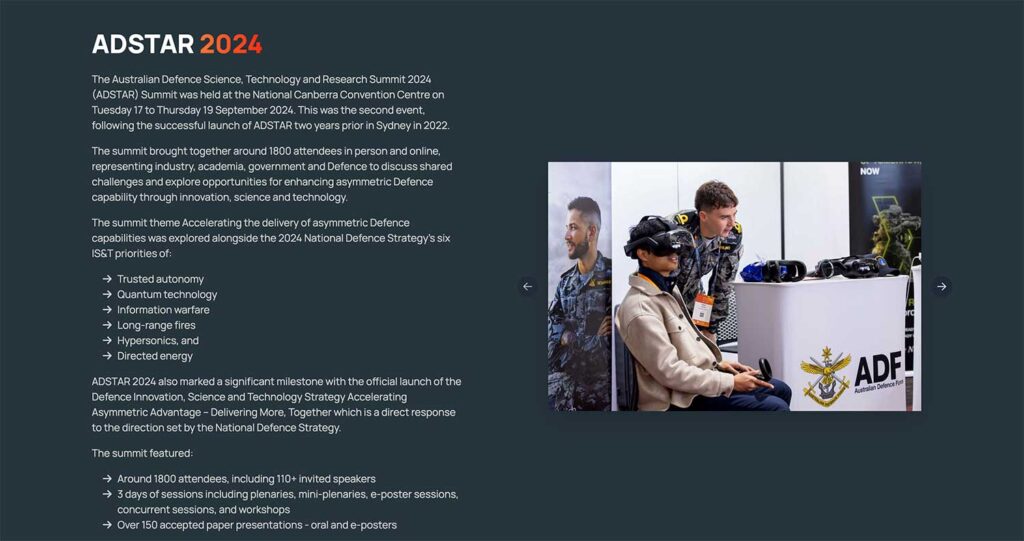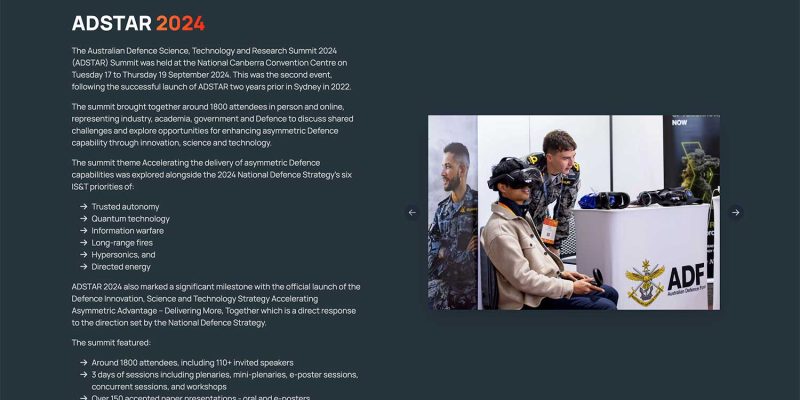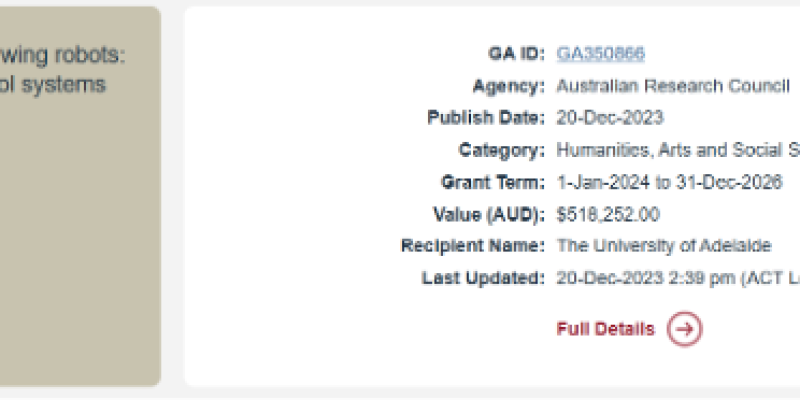Degrees of Defence: Ties between Australian Universities, the Defence Industry and Autonomy Research
As militaries around the world invest in emerging technologies, Australian universities have become key players in defence innovation. From funding streams to ethical debates, understanding these evolving partnerships is critical to ensuring responsible research and public accountability.
The extent and complexity of the relationship between Australian universities and defence technology development has intensified over the past decade. A recent example of this is the announcement of three million dollars in funding for defence research project to be channelled through the Defence Innovation Partnership (DIP), one of five state-defence research partnerships within the Australian Defence Science and Universities Network (ADSUN).
A web of partnerships exists that remains largely out of public view. It is almost impossible to paint a true picture of defence industry-funded research, because there is no publicly-available, centralised database. Instead, defence funding flows through a complex web of university-hosted research groups, innovation hubs, and tech incubators, forming a circuitous, often opaque network that is difficult to trace.
As advocates for humanitarian approaches to security, SafeGround believes transparency is crucial when examining these connections, particularly regarding autonomous weapons systems technology. This initial investigation maps the growing convergence between Australian universities, government defence agencies, and the defence industry, yet offers only a glimpse of the vast resources now being funnelled into the development of autonomous systems.

What Are Autonomous Weapons Systems?
Autonomous weapons systems (AWS), also referred to as lethal automated weapons systems (LAWS) or ‘Killer Robots’, present a profound threat to humanity in that they remove human control from use-of-force decisions.
Although there is not yet a fixed definition of these weapons, the Australian Human Rights Commission (2024) describes lethal autonomous weapons systems as weapons systems capable of independently identifying and attacking targets, without human involvement. Similarly, The International Committee of The Red Cross (2022) refers to such weapons systems as those able to “select and apply force to targets without human intervention”.
Increasing autonomy is rapidly being integrated across more functions of weapons systems. The technology spans multiple domains: unmanned combat aerial vehicles in the sky, autonomous ground vehicles on land, and autonomous underwater or surface vessels at sea.
Autonomous weapons systems that can identify and select a target and attack, without any human verification or input, are cause for serious concern. Behind these capabilities lies a complex integration of artificial intelligence, machine learning, advanced sensors, and decision-making algorithms that remove human control, delegating life-death decisions to machines.
The Rise of Autonomous Weapons: Robots Fighting Wars: The Future of War, is a video created by the International Committee of the Red Cross, illustrating the true nature of autonomous weapons.
The Growing Academic-Defence Partnership in Australia
A quiet revolution is underway across Australian campuses. Universities are increasingly forming powerful partnerships with the Department of Defence and defence industry corporations, providing advanced research capabilities in exchange for substantial funding and resources. In July 2023, for instance, in a significant boost to Australia’s autonomous weapons research capacity, the Albanese Government launched the Advanced Strategic Capabilities Accelerator (ASCA) with a substantial financial commitment. The initiative secured $748 million for its first four years of operation, expanding to a decade-long investment of $3.4 billion. That’s an extra $591 million on top of what was already earmarked for defence innovation, which underscores just how seriously the government is backing this sector.
Such funding injections signal the government’s determination to accelerate development of next-generation autonomous systems for national security purposes. They also raise important questions about institutional priorities and ethical considerations. For instance, researchers and ethicists are increasingly debating whether university involvement in autonomous weapons development conflicts with academic traditions of openness and humanitarian values.
The Academic-Military Pipeline

Australian universities have become deeply integrated with military research through a sophisticated partnership framework that streamlines defence funding and collaboration across the entire higher education sector. The scale and complexity of these relationships, combined with limited public disclosure of certain projects, makes providing a comprehensive overview of university-defence collaboration challenging.
According to the Defence Science and Technology Group webpage, university-defence partnerships benefit both parties by smoothing the path for:
- National Reach: Every Australian public university participates in the Defence Science Partnerships (DSP) program, Australia’s largest military-academic framework
- Streamlined Collaboration: Pre-negotiated agreements eliminate bureaucratic barriers between Defence and universities
- Comprehensive Engagement: Covers research projects, staff exchanges, infrastructure access, and equipment transfers
- Talent Development: Funds academic positions, postdoctoral research, scholarships, and PhD studies for Defence personnel
- Multi-Modal Partnerships: Enables both bilateral arrangements and joint research initiatives
- Research Center Creation: Facilitates establishment of specialized defence research hubs within university settings
Our investigation reveals that the majority of Australian universities maintain significant relationships with defence entities involved in autonomous systems research. The following examples of partnerships and networks merely scratch the surface of what is a complex, much larger web of collaboration and autonomy for defence research:
- Defence Science and Technology Group (DSTG): Cultivates industry-academia-government partnerships focusing on surveillance, space technologies, CBRN defence, robotics, automation and cybersecurity.
- Australian Defence Science and Universities Network (ADSUN): Facilitates cross-organizational collaboration within the defence ecosystem, connecting regional hubs including the Defence Science Centre (Western Australia), the Defence Innovation Network (NSW), the Queensland Defence Science Alliance, the Defence Innovation Partnership (South Australia and NT), and the Defence Science Institute (Victoria and Tasmania).
- Defence Trailblazer: This University of Adelaide and UNSW-led initiative aims to revolutionize researcher-industry collaboration on defence challenges, with $50 million each from government and universities plus an anticipated $140 million from industry, targeting 100 new defence technologies within four years.
- Security & Defence PLuS: A research collaboration between University of New South Wales (UNSW), King’s College London and Arizona State University (ASU) designed to advance the AUKUS agreement between Australia, the United Kingdom and the United States of America.
- The annual Australian Defence Science, Technology and Research (ADSTAR) Summit which gathers defence, industry, and academics to promote emerging technologies and collaboration.
To better understand how these funding mechanisms and partnerships materialise on the ground, it’s useful to examine individual universities. Several Australian institutions are not only recipients of significant defence-related funding, but also host dedicated research centres and labs focused on autonomy, robotics, and other dual-use technologies. Below is a snapshot of some key players in this rapidly evolving research landscape.
University of New South Wales (UNSW) Canberra at ADFA
UNSW Canberra operates in partnership with the Australian Defence Force Academy and receives substantial defence-related research funding. The university’s close ties to defence through the Defence Research Institute extend to various research areas including autonomous systems and swarm technology.
According to publicly available information from the UNSW website (2025), the university is a partner in the Centre for Advance Defence Research Enterprise – Operating in Chemical, Biological, Radiological and Nuclear Environments (CADRE-OCE group) and also hosts several defence-focused research centers, including The Trusted Autonomy Group, which explores human-machine teaming and autonomous decision-making systems, and The Capability Systems Centre, focusing on defence systems engineering. Partners include Defence Science and Technology (DST), the US Office of Naval Research, the US Air Force Office of Scientific Research and the US Army International Technology Center Pacific (ITC-PAC).
Queensland University of Technology (QUT)
QUT has positioned itself as a hub for robotics and autonomous systems research. The university’s partnerships include collaborations with the Defence Science and Technology Group (DSTG) and participation in the Trusted Autonomous Systems Defence CRC (Cooperative Research Centre)
The QUT-based Australian Centre for Robotics has developed vision-based navigation technology enabling autonomous vehicles to operate effectively in environments where GPS connectivity fails or is unreliable. Researchers have also recently taken steps forward in understanding how robots view and map their environments.
University of Melbourne
The University of Melbourne’s Defence Science Institute (DSI) plays a central role in linking academia, industry, and defence to grow the STEM ecosystem and support capability development through grants and collaboration. Its broader Melbourne Defence Enterprise connects academic research to military applications via multiple labs, including the Melbourne Information Decision and Autonomous Systems Lab (MIDAS), with backing from both Australian and US defence agencies.
In 2023, amid growing scrutiny of its ties with the defence industry, the university sought to clarify its relationship with Lockheed Martin Australia’s Science, Technology, Engineering Leadership and Research Laboratory (STELaRLab) (rebranded in 2024 as Advanced Systems and Technologies). While the university admitted to receiving $3.5 million in funding for PhD scholarships and research in AI, machine learning, and quantum sensing, it stressed that there is no $13 million partnership with Lockheed Martin, and that all research at the University of Melbourne is conducted in accordance with Australian law, adheres to relevant ethics and integrity codes, and is reviewed by the Research Due Diligence Advisory Group where appropriate.
RMIT University
RMIT University is very proud of its defence partnerships and promotes them openly through the Sir Lawrence Wackett Defence and Aerospace Centre, highlighting strong ties with industry and Defence. While its research policy prohibits work on weapons in breach of legal or international obligations, it acknowledges dual-use concerns. Unlike many institutions, RMIT is relatively transparent about its partnerships, which include (but are not limited to) the Australian Defence Forces (Army, Navy, Airforce), BAE Systems Australia, Boeing Defence Australia, the Defence Science and Technology Group (DSTG), Defence Science Institute (DSI), Defence Materials Technology Centre (DMTC), DefendTex, IMoog Australia, Leonardo, QinetiQ, Trusted Autonomous Systems CRC, Textron Systems, Thales Australia and the U.S. Department of defence.
University of Adelaide
The University of Adelaide in partnership UNSW Sydney are leading the Defence Trailblazer program, projected to inject $1.5 billion into the Australian economy over ten years. Framed as an effort to strengthen collaboration between industry, defence, and academia, the program is supported by a $50 million Federal Government grant and an additional $250 million from a mix of government, university, and industry contributions. In a parallel investment, the Federal and South Australian Governments are jointly funding the construction of an Advanced Defence Technologies Training Academy, with each government contributing $30 million (for a total of $60 million). From 2026 onwards, this academy will be operated by Adelaide University, a new institution formed by merging the University of South Australia and the University of Adelaide.
Two key research centres are also hosted by the University of Adelaide, namely The Australian Institute for Machine Learning and The Centre for Advanced Defence Research in Robotics and Autonomous Systems. University publications indicate participation in defence technology research programs with a recent project focusing on swarm coordination algorithms for multiple autonomous platforms. These are computational methods that enable a group of robots or drones (the “swarm”) to operate together efficiently without centralised control. These algorithms allow each autonomous unit, be it a drone, ground robot, or underwater vehicle, to make decisions based on local information while collectively working towards a shared goal.
This video was created by a student from the University of Adelaide. It gives an insight into the process of developing autonomous systems technology, as though they are more like toys, not potential lethal weapons.
Educational Pathways and Research Opportunities
Behind closed laboratory doors, tomorrow’s defence technologies are taking shape through various educational pathways. Based on publicly available research publications and grant announcements, key research areas include:
- Computer vision and sensor fusion
- Navigation systems for unmanned vehicles
- Swarm intelligence and multi-agent systems
- Human-machine teaming
- Artificial intelligence for decision support
Relevant Degree Programs
Of Australia’s 43 universities, a significant number now offer programs that equip students with skills relevant to the development of autonomous systems. The examples below highlight key courses and research areas across some of the country’s leading tertiary institutions, and serve as only a cross-section of the many courses available across varied disciplines.
Click on the arrows to view study and research programs listed by Australian States
THE AUSTRALIAN CAPITAL TERRITORY
| Australian National University (College of Engineering, Computing and Cybernetics) ANU Defence Institute | Bachelor of Computing (BCOMP) Bachelor of Software Engineering (Honours) (ASENG) | Master of Applied Cybernetics Master of Machine Learning and Computer Vision | Intelligent Systems Algorithms which enhance robotic decision-making |
| Canberra Institute of Technology | Diploma of Forensic Identification (Facial) Forensic Identification (Biometrics) | Comparing facial images to ID individuals Biometrics analysis for ID purposes | |
| University of Canberra | Bachelor of Engineering Bachelor of Information Technology Bachelor of Software Engineering | Master of Engineering Master of Information Technology and Systems | The integration of robotic systems with artificial intelligence: humanoid robots, robotic arms, mobile robotic platforms Technology enabling intuitive hands-free, eyes-free interfaces that connect remote communities and allow soldiers to maintain situational awareness while operating robotic systems Robots which display empathy: Towards Robotic Empathy– A human centred approach to future AI powered machines DTF-Tactical Cueing System for Threat and Degraded Visual Environments for Army Aviators and Dismounted Soldiers |
| UNSW Canberra UNSW Australian Defence Force Academy (ADFA) | Bachelor of Engineering (Aerospace, Mechanical, Electrical) | Master of Systems Engineering PhD in Autonomous Systems | Military applications, human-machine teaming |
NEW SOUTH WALES
| Macquarie University | Security, intelligence and criminology | ||
| University of Sydney Defence Science and Technology Group (DSTG) | Bachelor of Engineering (Mechatronic Engineering) Bachelor of Advanced Computing Bachelor of Electrical Engineering | Master of Engineering (Mechanical Engineering) | Australian Centre for Robotics Robot comprehension of, interaction within and safe movement within the environment Collaborative autonomy Smart cars’ ‘x-ray’-like vision |
| University of Technology, Sydney | Bachelor of Mechanical and Mechatronic Engineering Bachelor of Engineering Science Bachelor of Artificial Intelligence | Master of Engineering Master of Artificial Intelligence | AI applications enabling autonomous systems, including self-driving vehicles, facial recognition technology, adaptive learning platforms, and voice-activated digital assistants The Australian Artificial Intelligence Institute |
QUEENSLAND
| Central Queensland University (CQUniversity) | Cert II in Autonomous Technologies Bachelor of Engineering Bachelor of Engineering Technology | Application of Deep Learning in Autonomous Control of Unmanned Aerial Vehicles (UAVs) in Mobile, Wireless Networks | |
| Queensland University of Technology (QUT) | Bachelor of Engineering (Robotics and Mechatronics) | Master of Robotics and AI | Computer vision, robotic navigation |
TASMANIA
| University of Tasmania Australian Maritime College (AMC) | Bachelor of Maritime Engineering Bachelor of Engineering Technology Bachelor of Information and Communication Technology Bachelor of Science | Master of Maritime Engineering Master of Engineering Technology Master of Information and Communication Technology | Training software “Romulus” (2020) Autonomous maritime systems |
VICTORIA
| La Trobe University | Bachelor of Engineering Technology Bachelor of Computer Science Bachelor of Information Technology | Master of Artificial Intelligence Master of Engineering | AI and Machine Learning Machine learning, data mining, computer vision, natural language processing (NLP) |
| Monash University | Bachelor of Engineering (Robotics and Mechatronics Engineering) | Master of Advanced Robotics Engineering | Emerging Technologies Research Lab Intelligent robotics and Autonomous Systems |
| RMIT University | Bachelor of Mechanical Engineering Advanced Manufacturing and Mechatronics) Bachelor of Engineering (Software Engineering) Bachelor of Advanced Engineering (Manufacturing and Mechatronics) | Master of Engineering (Robotics and Mechatronics) Geospatial AI and spatial computing Data61 PhD Scholarship PHD Scholarship in Artificial Intelligence PhD Scholarship in Computer Vision and Machine Learning | Target Detection & Tracking DimSim (Deep Intelligence Machine Simulator) Sir Lawrence Wackett Defence and Aerospace Centre Trusted Autonomous Systems CRC |
| University of Melbourne | Engineering (Mechanical) AI for Robotics | Master of Engineering (Aerospace) Innovate: Research programs | CADRE-OCE | Multi-agent systems, AI decision-making Centre for AI and Digital Ethics Mechanical Engineering – Networked Systems Lab Active Collaborative CBRN Environment Sense and Sense‑making System (ACCESSS) ACCESSS creates extensive sensor networks detecting CBRN threats through multiple deployment methods, using analytics and modeling to identify actionable security risks requiring intervention |
SOUTH AUSTRALIA
| University of Adelaide | Bachelor of Engineering, Computer Science | Master of AI and Machine Learning Master of Engineering (Mechatronic) | Swarm intelligence, computer vision Drone-tracking systems |
WESTERN AUSTRALIA
| Curtin University | Bachelor of Electronic and Electrical Engineering Bachelor of Mechanical Engineering Bachelor of Computer Science | Master of Professional Engineering Master of Artificial Intelligence | Mine Countermeasure Unmanned Underwater Vehicles (MCMUUVs) for mine detection and neutralization. AI, facial recognition and surveillance |
| University of Western Australia UWA Defence and Security Institute | Bachelor of Engineering (Automation and Robotics Engineering) | Honours in Computer Science and Software Engineering | Technologies to enhance decision-making, build trust, optimize performance through evolutionary algorithms, and enable autonomous environmental navigation, independently or human-guided |
Following the Money: Funding Mechanisms and Research Initiatives
The flow of defence funding into university research creates powerful incentives and shapes research priorities. Several major programs channel public money into university-led defence research into autonomous systems technologies, three of which are:
- The Advanced Strategic Capabilities Accelerator: The Advanced Strategic Capabilities Accelerator (ASCA) is tasked with rapidly advancing innovative, non-traditional defence solutions. Its mission is to speed up the development and integration of asymmetric technologies into the Australian Defence Force, directly addressing evolving strategic and operational priorities.
- The Next Generation Technologies Fund: This program, administered by the Defence Science and Technology Group, invests in emerging technologies. Public information indicates universities have received grants for research in autonomous systems, though specific weapons applications are not always detailed in public documents.
- Trusted Autonomous Systems Defence CRC: This Cooperative Research Centre brings together industry, academia, and defence stakeholders. According to their website, they focus on developing autonomous systems capabilities with defence applications. A notable project from this collaboration is the development of autonomous underwater vehicle technology that can operate independently for extended periods, with potential applications ranging from environmental monitoring to naval operations.
Different Perspectives on University-Defence Partnerships
The ever-increasing entanglement between universities and the defence sector continues to provoke debate. These three viewpoints represent just a fraction of the diverse stakeholder perspectives on defence-university collaborations.
University Leadership View
Many university leaders frame defence partnerships as critical funding sources and innovation drivers. For example, commenting on the 2022 Defence Trailblazer: Concept to Sovereign Capability (CSC) initiative, a collaboration between the UNSW and the University of Adelaide, UNSW Vice-Chancellor Professor Attila Brungs emphasised the value of applied research, describing the program as a vehicle to deliver “real-world outcomes” for Australia’s defence industries.
Defence Industry Perspective
From the defence industry side, collaboration is framed as essential to accelerating innovation. A Defence Trailblazer-funded project announced in April 2023 between UNSW and Akula Tech focuses on autonomous drone swarms designed to adapt to changing battlefield conditions. Dr Margaret Law, General Manager of Technology Development & Acceleration at Defence Trailblazer, highlighted the project’s potential to deliver “effective and efficient operational tools.”
This partnership model is explored in greater depth in a November 2023 Debate@Go8 podcast episode, in which Defence Trailblazer Executive Director Dr Sanjay Mazumdar examines artificial intelligence in autonomous weapons, the implications of the AUKUS alliance, and the blurred lines between civilian and military applications in emerging defence technologies:
Critical Voices
While university leadership and defence officials are both enthusiastic about strengthening these partnerships, not all academics or students welcome the trend. Some raise ethical concerns about the militarisation of university research, particularly as public research funding becomes increasingly scarce. In a 2018 article for The Conversation, scholars Tilman Ruff and Alex Edney-Browne warned that growing ties between universities, defence agencies, and weapons manufacturers pose substantial ethical challenges: “Intensifying ties between universities, the Department of Defence and weapons manufacturers make sense within the government’s wider militarisation efforts. But they may not be ethically justifiable.”
Within the context of Israel’s horrific attacks on Gaza, there is increasing community action rejecting ties to defence and arms manufacturers. Staff and students at the University of Melbourne have been engaged in an 8-year clash with the university over its arms industry partnerships, in particular with Lockheed Martin, Boeing, BAE Systems and the US Department of Defence. More recently, members of the RMIT community signed an open letter calling upon leadership to “demilitarise” and sever all links with “the military-industrial-academic complex”. Yet university administrators remain averse to disclosing the depth and breadth of their dealings with arms corporations and the US military.
These conflicting perspectives raise further questions about how much of this research is visible to the public, and what remains behind closed doors.
Transparency Challenges in Australia
Australian institutions tend to limit public disclosure around sensitive defence research projects, particularly in research areas such as autonomous weapons technology, effectively cloistering public understanding of the full scope and implications of ongoing research.
Tracking Funding with GrantConnect
GrantConnect, the Australian Government’s central portal for grant funding, sheds some light on publicly funded defence research. Its database features a wide range of grants focused on robotics and autonomous technologies, such as a $3.28 million Australian Research Council grant for autonomous systems development awarded to the University of Technology Sydney in 2019. However, project descriptions are often vague or heavily redacted, limiting meaningful public insight and raising questions about the transparency of research outcomes.

Declassified Australia’s 2024 investigation highlighted similar gaps, revealing that funding relationships between US defence entities and Australian universities are often opaque and poorly disclosed to the public.
Balancing Openness and Security
As the push for autonomous weapons research grows, driven by geopolitical competition, industry momentum, and strategic defence priorities, questions emerge about how universities can uphold transparency while meeting national security needs. Institutions are increasingly caught between the academic commitment to open inquiry and the classified nature of defence research. Navigating this tension is particularly complex in Australia, where disclosure practices remain inconsistent and public visibility into research partnerships is often limited. The challenge is not only about protecting sensitive information but also about preserving public trust, maintaining research integrity, and ensuring that the academic sector remains a space for critical, ethical reflection.
Potential Frameworks for Ethical Oversight and Risk Management
Transparency vs. Security: How can universities balance open academic discourse with legitimate security concerns?
- Introduce tiered disclosure protocols and open publication for fundamental research, with controlled access for sensitive applications.
Ethical Oversight: What governance structures should guide university participation in defence research?
- Establish dedicated defence research ethics panels with diverse academic, legal, and public representation.
Humanitarian Impact: How can the potential humanitarian consequences of emerging technologies be properly assessed?
- Embed humanitarian impact assessments into project approval stages, as is common practice with environmental reviews.
Looking Forward
For critics of autonomous weapons systems, following the money isn’t just about transparency, it’s about accountability. Mapping the defence research ecosystem is a critical step in pulling back the curtain on how warfighting technologies are being quietly developed within tertiary institutions. By identifying who funds what, and where, we can sharpen public debate, push for ethical safeguards, and futureproof against the misuse of these powerful and potentially destabilising weapons systems.
SafeGround continues to push for humanitarian approaches to defence innovation, but urgently calls for a deeper understanding of the complex web connecting academia, government and industry in Australia. This clarity is critical now as sophisticated autonomous systems technologies rapidly evolve, leaving little time for proper assessment of their implications.





